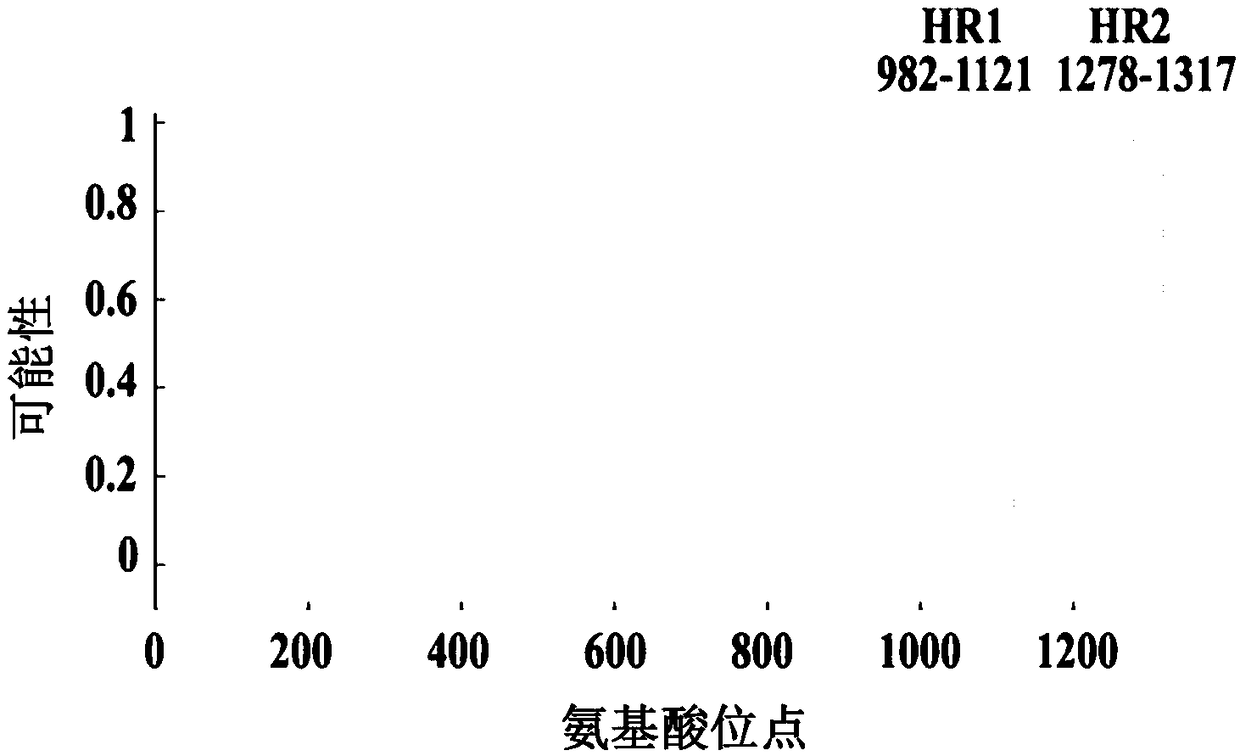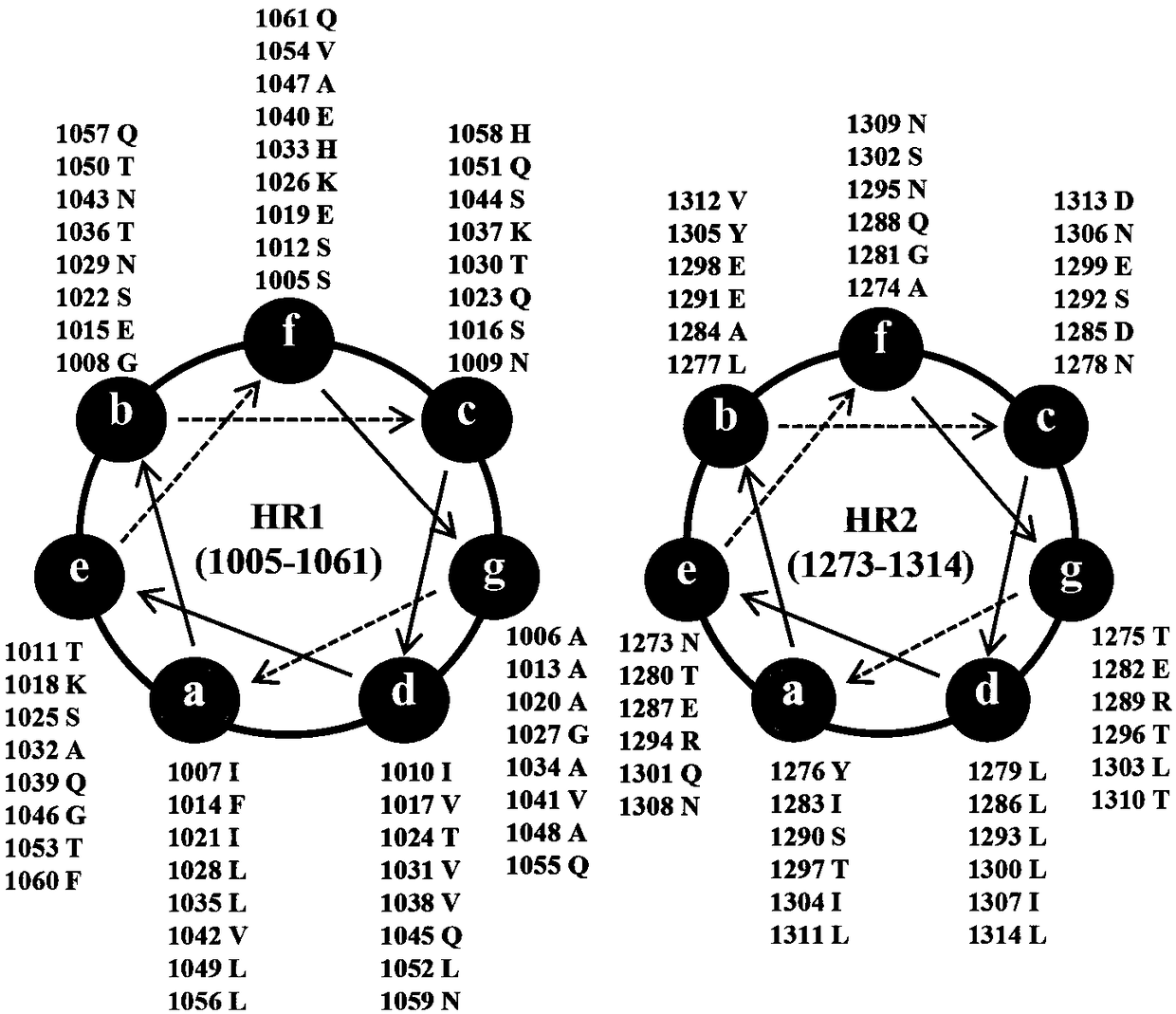Polypeptide for inhibiting porcine epidemic diarrhea virus (PEDV) infection, and application of polypeptide
A technology for porcine epidemic diarrhea and virus infection, which is applied in the fields of bioinformatics, cell biology and virology, and can solve problems such as anti-virus infection
- Summary
- Abstract
- Description
- Claims
- Application Information
AI Technical Summary
Problems solved by technology
Method used
Image
Examples
Embodiment 1
[0021] Example 1. PEDV HR2 Prediction
[0022] HR1 and HR2 of S protein of PEDV CH / hubei / 2016 strain were predicted by online software LearnCoil-VMF (http: / / night-ingale.lcs.mit.edu / cgi-bin / vmf). The LearnCoil-VMF software recognizes typical HR features, that is, there are about 3 to 4 heptavalent repeats in HR1 and HR2 respectively, and each repeat starts from leucine or isoleucine. The result is as figure 1 As shown, the predicted HR1 and HR2 of PEDV S protein are located at amino acids 982-1121 and amino acids 1278-1317, respectively.
Embodiment 2
[0023] Embodiment 2.PEDV HR2 derived polypeptide design
[0024] The human coronavirus NL63 (HCoV-NL63) HR1 and HR2 amino acid sequences that have been analyzed with reference to the fusion core crystal structure ( figure 2 , wide frame), PEDV HR1 and HR2-derived polypeptides were designed, and finally amino acids 1005-1061 and 1273-1314 were selected as HR1 and HR2-derived polypeptide sequences, and the amino acid sequences were SAIGNITSAFESVKEAISQTSKGLNTVAHALTKVQEVVNSQGAALTQLTVQLQHNFQ (SEQ ID NO.1) and NATYLNLTGEIADLEQRSESLRNTTEELQSLIYNINNTLVDL (SEQ ID NO. 2). After analysis, its amino acid composition conforms to the characteristics of the seven-valent repeat of coronavirus, that is, a group of neatly arranged seven-valent repeat amino acid residues, and its residue positions can be represented by a, b, c, d, e, f and g, where a and The amino acid residue at the d position is a hydrophobic amino acid or an amino acid with a large side chain ( image 3 ). The HR1 and HR2...
Embodiment 3
[0025] Example 3. PEDV HR2-derived polypeptide inhibits PEDV from infecting host cells
[0026] 3.1 PEDV HR2-derived peptides inhibit the proliferation of PEDV
[0027] The PEDV host small intestinal epithelial cells IPEC-J2 were divided into 2 × 10 5 cells / mL, 500 μL / well for 24-well plate, at 37°C CO 2 Cultivate in the incubator for 24h. PEDV CH / hubei / 2016 strain and HR1, HR2 synthetically derived polypeptides were respectively diluted in serum-free DMEM medium (Gibco, USA). The multiplicity of infection (MOI) of the virus was 1. DMEM medium containing virus and dimethyl sulfoxide (DMSO) was used as control. After mixing the virus with MOI=1 and the synthetically derived polypeptide with a final concentration of 0.1-1000 nM, place it at 37° C. for 1 hour. The plate was washed 3 times with PBS, 500 μL of the mixed solution was added to each well, and three replicate wells were set up for each group of treated cells. After incubating at 37°C for 1 h, wash the plate three ...
PUM
 Login to View More
Login to View More Abstract
Description
Claims
Application Information
 Login to View More
Login to View More - R&D
- Intellectual Property
- Life Sciences
- Materials
- Tech Scout
- Unparalleled Data Quality
- Higher Quality Content
- 60% Fewer Hallucinations
Browse by: Latest US Patents, China's latest patents, Technical Efficacy Thesaurus, Application Domain, Technology Topic, Popular Technical Reports.
© 2025 PatSnap. All rights reserved.Legal|Privacy policy|Modern Slavery Act Transparency Statement|Sitemap|About US| Contact US: help@patsnap.com



